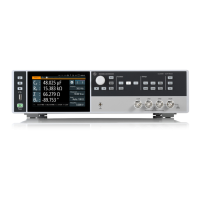Instrument functions
R&S
®
LCX Series
74User Manual 1179.2260.02 ─ 02
measurement result. The cable length correction compensates these parasitic
transmission characteristics.
As a rule, make sure to keep the connection between the R&S LCX and the com-
ponent under test as short as possible, even more, the length must not exceed
1 m.
When using test fixtures with cables, the cable length correction function reduces
the impact of cable losses to a minimum, and thus compensates the parasitic
transmission characteristics. See "Cable Length" on page 76 for the correspond-
ing setting.
●
Test signal type
The R&S LCX provides either the signal voltage or the signal current for setting the
test signal level, see "Test Signal Type" on page 76. If the signal current is
defined, the set value corresponds to the maximum current that flows when short-
circuited.
●
External voltage bias
See "Voltage Bias" on page 76.
●
Source impedance
By default, the R&S LCX measures with an output impedance of 100 Ω over the
entire measurement range, i.e. with low source impedance ("Low Z"). For certain
applications, e.g., the measurement of low-impedance components, you can set
the output impedance to 10 Ω ("High Z").
See "Source Impedance" on page 76.
●
Open/Short/Load correction
The numerous types of passive components with a wide variety of shapes require
suitable test fixtures, which in turn are equipped with or without test leads, clips or
probes, etc. As a result, measurement errors due to the test setup and used equip-
ment can occur. In particular, residual impedance, admittance, stray capacities or
environmental factors can impact the measurement.
Using the open/Short/Load correction technique, the R&S LCX compensates such
impacts.
The open/short correction, e.g. offsets residuals of test fixtures. For complex errors,
you can use the load correction function, which refers to a reference component,
e.g., a reference resistor. We recommend that you execute Open/Short and Load
correction when the measurement setup covers cable lengths other than standard
cables, user-specific test fixtures or additional passive circuits or components, etc.
●
Auto function
The R&S LCX determines the component type of the DUT automatically, based on
the measured impedance and phase angle. The auto function allows you to set the
threshold values for the phase angle and the serial or parallel separation point.
The measurement principle distinguishes between pure and mixed measurement
pairs, i.e. measurement pairs with only real values (Rs-X,...), and measurement
pairs with additional imaginary components (LS-R).
Figure 5-1 under Measurement basics illustrates the relations.
See "Auto Function" on page 77.
Measurement parameters

